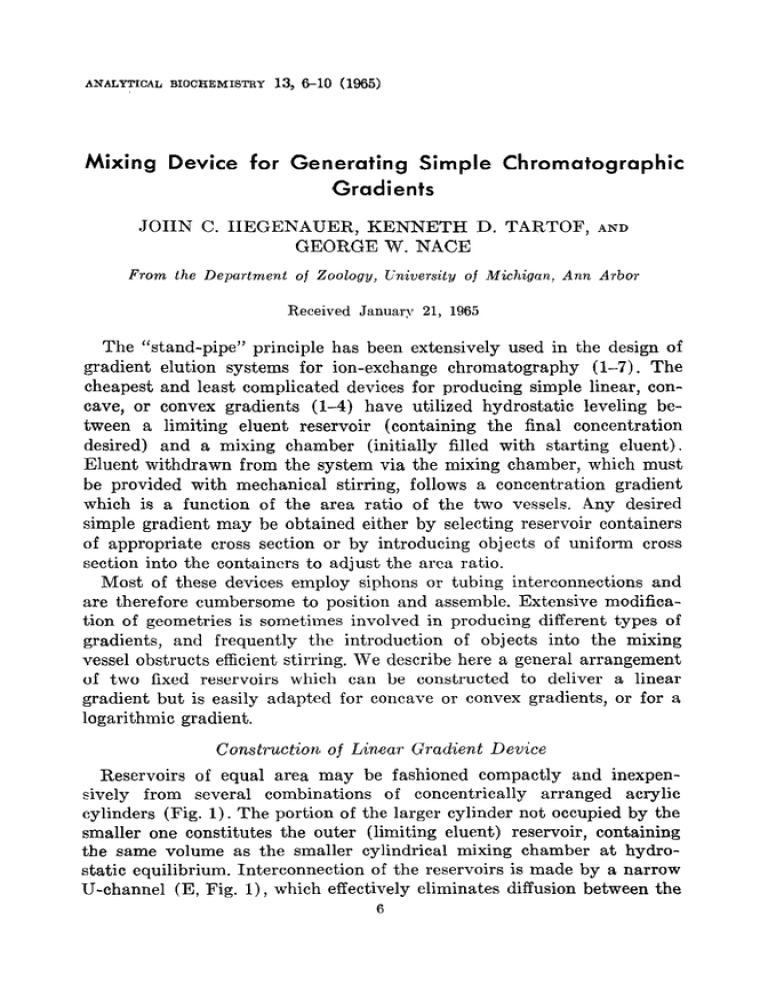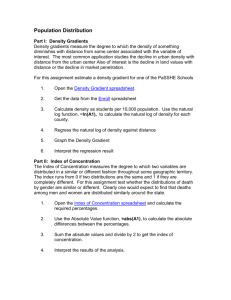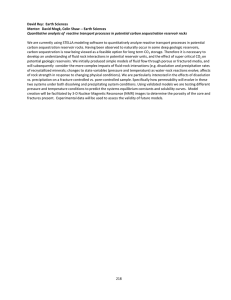Mixing Device for Generating Simple Chromatographic Gradients
advertisement

ANALYTICAL BIOCKEMISTBY Mixing Device 13, for 6-10 (1965) Generating Simple Chromatographic Gradients JOHN From the C. HEGENAUER, KENNETH D. TARTOF, GEORGE W. NACE AND Department Arbor of Zoology, Received Cniversity January of Michigan, Ann 21, 1965 The “stand-pipe” principle has been extensively used in the design of gradient elution systems for ion-exchange chromatography (l-7). The cheapest and least complicated devices for producing simple linear, concave, or convex gradients (l-4) have utilized hydrostatic leveling between a limiting eluent reservoir (containing the final concentration desired) and a mixing chamber (initially filled with starting eluent). Eluent withdrawn from the system via the mixing chamber, which must be provided with mechanical stirring, follows a concentration gradient which is a function of the area ratio of the two vessels. Any desired simple gradient may be obtained either by selecting reservoir containers of appropriate cross section or by introducing objects of uniform cross section into the containers to adjust the area ratio. Most of these devices employ siphons or tubing interconnections and are therefore cumbersome to position and assemble. Extensive modification of geometries is sometimes involved in producing different types of gradients, and frequently the introduction of objects into the mixing vessel obstructs efficient stirring. We describe here a general arrangement of two fixed reservoirs which can be constructed to deliver a linear gradient but is easily adapt,ed for concave or convex gradients, or for a logarithmic gradient. Cons&uctiofL of Linear Gradient Device Reservoirs of equal area may be fashioned compactly and inexpensively from several combinations of concentrically arranged acrylic cylinders (Fig. 1). The portion of the larger cylinder not occupied by the smaller one constitutes the outer (limiting eluent) reservoir, containing the same volume as the smaller cylindrical mixing chamber at hydrostatic equilibrium. Interconnection of the reservoirs is made by a narrow U-channel (E, Fig. l), which effectively eliminates diffusion between the 6 CHROMATOGRAPHIC GRADIENT MIXER FIG. 1. Cross-sectional diagram of gradient device showing relative positions of essential ingredients. Outer and inner cylinders A and B are glued to 1/2r’ acrylic plate (G) to form fixed concentric reservoirs of equal area. Plastic rod C allows rotation of a snugly fitting stopcock of j/,” Teflon rod D, which is drilled to match configuration of the 5/6~” U-channel (E) connecting outer and inner reservoirs. The central mixing chamber, shown with magnetic stirring bar J in place, is provided with narrow outflow channel F. Connection is made to a chromatographic column with plastic tubing, which may be fit directly into undersized expansion H. two chambers and allows sufficiently rapid equilibration to accommodate fast chromatographic flow rates. At one portion of the channel, a “stopcock” (D, Fig. 1) is interposed to allow convenient priming and to permit independent filling of the reservoirs. A large variety of cylinders is commercially available, and the selection of appropriate sizes to produce “matching area” combinations is tedious. Table 1 provides a convenient listing of available “matching area” cylinder combinations1 with less than 2% difference in the reservoir areas as calculated from the nominal diameters of the two cylinders. Modification for Nonlinear Gradients Concave or Convex Gradients. The area ratio of many combinations of Table 1 may be altered systematically tion of a variety of convex and concave gradients by numbers of close-fitting acrylic cylinders around or ‘Specifications for “Cadco” cast acrylic materials available from: Cadillac Plastic Detroit 3, Michigan. Uniform inventories of the reservoir for the producnesting different inside the fixed resin tubes, Teflon rod, and cementing and Chemical Co., 15111 Second Ave., prevail among many manufacturers. 8 HEGENAUER, SUGGESTED COMBINATIONS CONSTRUCTION OF FIXED TARTOF, AND NACE TABLE 1 OF COMMERCIALLY AVAILABLE CYLINDERS FOR THE “MATCHING AREA” RESERVOIRS TO GENERATE A LINEAR GRADIENT &, A,, = areas computed from inner and outer diameters of cylinders. AI, A0 = areas of reservoirs (mixing chamber and limiting eluent reservoir, respectively) resulting from the combination of these cylinders. AO = Ai (outer cylinder - A, (inner cylinder). Diameters and areas in inches t,o conform to manufacturers’ specifications (1 in.2 = 6.45 cm”). Outer cylinder Inner i.d. Ai ad. i.d. 1.875 2.125 2.500 3.000 3.375 3.625 4.000 4.250 4.500 4.875 5.125 5.500 5.750 7.250 2.761 3.547 4.909 7.069 8.946 10.321 12.566 14.186 15.904 18.666 20.629 23.758 25.967 41.283 1.500 1.625 2.000 2.250 2.500 2.750 3.000 3.125 3.375 3.625 3.750 4.000 4.250 5.250 1.125 1.375 1.500 2.000 2.250 2.375 2.625 2.875 3.000 3.250 3.500 3.750 3.875 5.000 Ratio of reservoir cylinder A. Ai 1.767 2.074 3.142 3.976 4.909 5.940 7.069 7.670 8.946 10.321 11.045 12.566 14.186 21.648 0.994 1.485 1.767 3.142 3.976 4.430 5.412 6.492 7.069 8.296 9.621 11.045 11.793 19.635 A0 0.994 1.473 1.767 3.093 4.037 4.381 5.497 6.516 6.958 8.345 9.584 11.192 11.781 19.635 .zz; 1.000 1.00s 1.000 1.016 0.985 1.011 0.984 0.996 1.016 0.994 1.004 0.987 1.001 1.000 center cylinder to reduce the area of the outer or inner reservoirs, or both. Figure 2 shows an assortment of gradients that could be produced if combinations of a series of 8 cylinders were nested into one of the linear gradient generators of Table 1. These gradients were calculated from the general formula (1) : 1 - C = (1 - z))Ao& where C = fraction of the limiting concentration attained when a fraction, V, of the total volume has been withdrawn from the mixer, and A,,, Ai = areas of the outer reservoir and inner mixing chamber, respectively. Logarithmic Gradient. When the central mixing chamber of any of the linear gradient generators of Table 1 is converted to a constant-volume reservoir by capping it tightly with a rubber. stopper, a logarithmic gradient (8) can be generated having characteristics circumscribed by the formula (1) : CHROMATOGRAPHIC FRKTION GRADIENT OF TOTAL GRADlENT 9 MIXER VOLUME FIG. 2. Assortment of gradients possible when one of the linear tors selected from Table 1 is modified with different combinations cylinders. The area ratio (outer reservoir/inner mixing chamber) curve is indicated. gradient generaof 8 nesting generating each where C = fraction of the limiting concentration attained when a fraction, v, of the fixed volume in the closed reservoir has been withdrawn from the mixer. Note that attainment of a satisfactory end point for such a gradient may require that an excess of limiting eluent in the outer reservoir be provided by refilling or initial adjustment. DISCUSSION The gradients generated by our device have been in excellent agreement with those calculated for different combinations of cylinders, although some deviation has been detected, probably attributable to the error inherent in some of the “matching area” combinations and the error introduced by manufacturing tolerances. These considerations do not apply if the actual area ratio is determined by measuring the volumes required to bring the solutions in the reservoirs to the same level. This method also provides direct visualization of the volume corrections that may be necessary to achieve equal hydrostatic pressures 10 HEGENAUER, TARTOF, AND NACE in the two reservoirs with eluent solutions of appreciably different densities. The compactness, simple design, and low cost, (under $25) of this device recommend it for the product.ion of many frequently required gradients. SUMMARY A linear gradient device consisting of two concentric reservoirs of equal cross-sectional area, in which the initial and limiting eluent solutions are maintained in hydrostatic equilibrium, may be constructed from several combinations of commercial acrylic resin cylinders. By the use of nesting cylinders, the areas of the reservoirs may be reduced independently, allowing an assortment of nonlinear gradients to be produced by simple adjustment of the area ratio of the two reservoirs. ACKNOWLEDGMENTS Supported in part by NIH grant CA 06929 and by an NIH grant GM 09203 to Tahir M. Rizki. We thank James E. Mite for technical assistance and John M. Allen for advice and criticisms. REFERENCES 1. PETERSON, E. A., AND SOBER, H. A., in “Methods in Enzymology” (S. P. Colowick and N. 0. Kaplan, eds.), Vol. V, p. 3. Academic Press, New York, 1962. 2. BOCK, R. M., AND LING, N.-S., Anal. Chem. 26, 1543 (1954). 3. PARR, C. W., in Proc. Biochem. Sot., 324th meeting, Biochem. J. 56, xxvii (1954). 4. KATZ, S., Anal. Biochem. 5, 7 (1963). 5. PETERSON, E. A., AND SOBER, H. A., Anal. Chem. 31, 857 (1959). 6. PETERSON, E. A., AND ROWLAND, J., J. Chromatog. 5, 330 (1961). 7. ANDERSON, N. G., BOND, H. E., AND CANNINQ, R. E., Anal. Biochem. 3, 472 (1962). Biochem. Biophys. 45, 235 8. LAKSHMANAN, T. K., AND LIEBERMAN, S., Arch. (1953).




